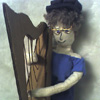
This weekend’s project is a thorough housecleaning and doing the library included shelving the last of the books from Kalamazoo 2013. So now it’s time to start the 2014 book-intake reviews.
Last year at Kalamazoo when I was still in the beginning stages of writing The Mystic Marriage, I searched all over for reference works on alchemy and beliefs about gemstones to no avail. This year (as I noted in my session blogs) magical gemstones and alchemy were all over the place. I think I really will have to write a bunch of Alpennian novels set in the Middle Ages just to justify all the reference books. And today’s books are:
Ebeling, Florian. 2007. The Secret History of Hermes Trismegistus: Hermeticism from Ancient to Modern Times. Cornell University Press, Ithaca. ISBN 978-0-8014-7749-2
Hermes Trismegistus was the legendary attributed author of a collection of mystical texts covering alchemy, astrology, medicine, and mysticism. This relatively brief guide (140pp not counting back matter) reviews the history and chronology of the various components of that tradition, both the philosophical branch centered in Italy and the more practical alchemical/medical branch, with an infusion of Arabic sources, that developed further north. The core of the Heremetic corpus was of genuine antiquity, but the iconic status of its putative author encouraged the accretion of other texts as well as “rediscoveries” of texts whose original composition is questionable. Ebeling follows the tradition all the way up through 20th century interpretations. The briefness and readability of this work encourages me to place it in my serious “to be read” pile (not my hypothetical “to be read” pile).
Láng, Benedek. 2008. Unlocked Books: Manuscripts of Learned Magic in the Medieval Libraries of Central Europe. The Pennsylvania State University Press, University Park. ISBN 978-0-271-03378-5
This and the following book are part of the fascinating and valuable “Magic in History” publications series from Pennsylvania State University Press. (They’re also associated with the Societas Magica group that put on several of my favorite sessions this year.) Láng’s work focuses on an under-studied topic, comparing and analyzing the contents and context of magical texts originating in (or used in) central and eastern Europe. After a discussion of the larger historic and philosophical context, there is a detailed (and copiously illustrated) look at focal topics such as image magic, divination using diagrams, alchemy, and ritual magic. The last section of the book addresses three main contexts in which these books were used: clerical, courtly, and university. My brief skim through the contents already has me brainstorming ideas for a future story.
Page, Sophie. 2013. Magic in the Cloister: Pious Motives, Illicit Interests, and Occult Approaches to the Medieval Universe. The Pennsylvania State University Press, University Park. ISBN 978-0-271-06033-0
Despite the intriguing title, this work looks to be of less use for my research than the preceding two. Although the general format and coverage is similar to Láng’s work, the contents feel at once more superficial and more anecdotal. There is a great deal of focus on the physical texts and their relationships but their content is mostly discussed narrowly in terms of “case studies”. The author’s primary purpose is to examine the integration of magical interests with a monastic life, so it’s understandable that there is less of a focus on the practial aspects of magical practice.